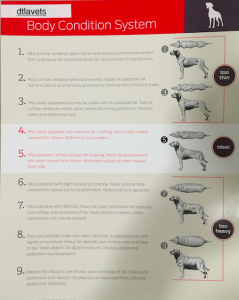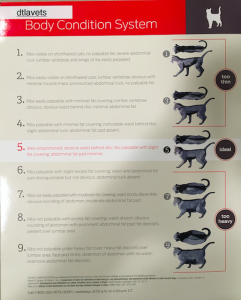This is probably one of the most common questions we are asked as veterinarians. For us the number on the scale is not nearly as important as the body condition score (BCS) of the pet. The body condition score (BCS) is a tool used for distinguishing differences in nutritional needs of pets. It assigns a number from 1-9, with 1 out of 9 representing an emaciated body condition, and 9 out of 9 representing an obese body condition. Five out of 9 is just right, - that is “a perfect 10” in humans translates into a “perfect 5” for our pets! If your pet has that perfect 5 out of 9 BCS, then whatever the number on the scale says is right for that particular pet. Remember that just like in humans, the body condition of a pet will be influenced by genetics, individual metabolism and other health conditions.
A BCS of 1/9 - 4/9 represents various degrees of being underweight. The ribs and hip bones of these animals are easily felt and seen. Animals in this range may have gastrointestinal or hormonal disease that do not allow them to assimilate the nutrients that they eat. They may have intestinal parasites. Or sadly they may just be homeless animals that are simply starving. It is true, however that we do prefer some pets to achieve a 4/9 BCS if there are issues like arthritis or a missing limb. Carrying slightly less weight on these frames is easier for the pet and is a huge part of pain control.
A BCS of 6/9 - 9/9 represents various degrees of being overweight. The ribs and hips bones of these pets are difficult or impossible to feel or see. Animals in this range may have hormonal problems like hypothyroidism. But the honest truth is that most pets in this range are simply being overfed by their owners. We do prefer rapidly growing puppies and kittens to fall into a 6-7/9 BCS but once they stop growing they really must slide into a 5/9 BCS. There really isn’t any other circumstance that we would encourage a pet to fall into a 6-9/9 BCS.
So what are the characteristics of a perfect 5? The ribs can be felt without excess fat covering - they should feel like the back of your hand bones (not like the palm of your hand and not like your knuckles). The waist line is easily seen when viewed from above and the abdomen is tucked up when viewed from the side.
Remember that some animals have long or fluffy coats that make visualization of ribs and waistlines less obvious. With these animals you must use your hands as your eyes for evaluating the BCS. Check out this chart to help you assess your pet’s BCS.
Still not sure what your pet’s score is? Come visit us this Saturday, December 12, as we help celebrate the grand opening of DTLA’s Just Food For Dogs Pantry. DTLAvets staff will be providing complimentary BCS. Come chat with us about nutrition. Bring your pet to jump on the scale. There will be treats and goodies for everyone!

